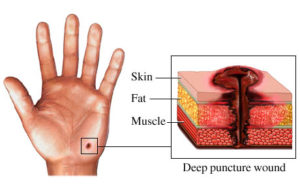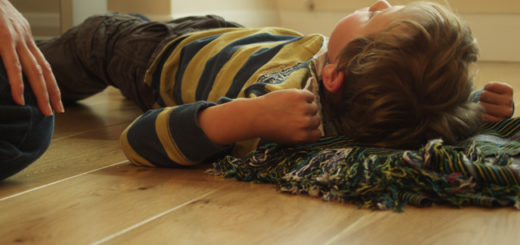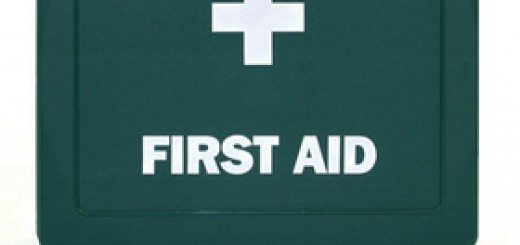First aid for puncture wounds
What is a puncture wound?
A puncture wound occurs when an object pierces the skin and enters into the body. This creates an open wound which is painful and may be bleeding.
Punctures may occur due to any sharp objects such as glass, scissors, knives, pins, nails, wood splinters and sharp stones. The object may remain embedded in the wound or may have passed clean through the body part involved.
Puncture wounds can be dangerous as it is difficult to tell how deep the injury is. Damage to underlying blood vessels can cause serious bleeding to occur.
First aid for a puncture wound
- Do not remove the object unless it is very small (for example,a small splinter)
- Stop the bleeding by applying pressure around the wound – take care not to dislodge the object
- If possible, elevate the limb to prevent further blood loss
- Seek urgent medical attention
It is important to keep the object as still as possible to prevent further injury to the deeper structures below the skin and minimise any bleeding.
Whilst it is tempting sometimes to attempt to remove the object, this can actually worsen the situation by causing further bleeding and tissue damage. Removal of embedded objects should only be carried out by a qualified healthcare professional.
Puncture wounds are at a high risk of becoming infected. Seek early medical advice if there are any signs of infection such as swelling, warmth, pain or discharge.







This is good information to know! Since you typically can’t apply pressure directly to the wound – for fear of displaying the lodged in object – are there any specialized methods for it?
I cringe when television shows and movies show people pulling objects out of wounds. The rarely show the the aftermath, with blood gushing out because the object was keeping pressure on the severed blood vessels.
Remember, if an object must stay in place, it must be stabilized to keep it from moving i around and making the wound larger!
Thanks for providing the concise overview on how to apply first aid for puncture wounds! Even though most of the concepts are easily comprehensible, it’s amazing how many people may forget these fundamentals should a more serious puncture arise.
Natural instinct would be to pull out the object pierced into the skin as quick as possible, but like it’s stated here, what we would cognitively define as a practical way to stop the problem ends up making the situation worse. And another surprising thing is that some people leave an open wound without seeking professional help. I remember a friend that had a toe cut and decided it wasn’t going to be a problem.
It was until he went to the beach that it got infected, and he had to spend a few weeks getting it healed. Things like this, despite of how common sense they are, are vital to avoid those types of circumstances. So thank you very much for providing this here! And I’m looking forward to seeing more useful information throughout this blog!
I’ve always seen this conducted in entertainment media, but I haven’t really absorbed the information on how to handle a situation like this in case I find myself in it. I, however, am aware that you should never remove anything from a puncture wound, especially if the wound is deep because it could be the difference between destroying or injuring organs or arteries or simply the balance between life and death. So I’m here reading this post and finding it very valuable to my knowledge regarding the proper steps to take when handling such wounds.
My dad was a Hunter Safety teacher so I sat through many courses while he taught and being pretty young when I was doing this, I always remember the hunter tripping and falling on a stick. Thinking his gun would go off because it was a “hunter” safety course, the stick punctured him instead. His hunting partner was going to pull it out, but the victim told him not to.
This is very useful information to know as this type of accident can happen and anytime and any where. Not knowing how to take care of something like this could ultimately lead to death.
This is so scary. But I’m glad I know what to do now. I remember when I was little, seeing a little boy with a pencil stabbed through his hand. The nurse held it steady while she walked him out to the parking lot. This will definitely come in handy if this nightmare ever happens.
Great information! I think most people’s first reaction is to take it out, when that can do more harm than good. You don’t know if that object had severed any major blood vessels. Great post!
I had a medium size splinter on my left leg when I was 12, the size of half a finger. The skin around it was bluish and purple-ish. I didn’t want to let my parents know so I pulled it out myself. And it bled endlessly and my parents were so upset. The doctor said I am lucky not damaging any tissue. Now I’m a parent myself, I know what to do with my children when (cross finger) it happen. Thank you for letting us know.
What if the object in the wound is big and I may fear to put pressure on the wound in order to prevent bleeding, How else can I do it?